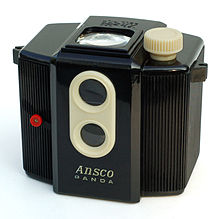Ansco
Ansco in 1907 as a photo company (cameras and film material) from the merger of the company of brothers Anthony ( An thony & Company) with Sco vill & Adams. The largest European film manufacturer, Agfa , merged with Ansco to form Agfa-Ansco in the United States in 1928 .
It should be noted the development of the early, only briefly used memo film cassette for the camera of the same name. As the forerunner of the similar Agfa Karat or Agfa Rapid - and today's 35 mm film cassettes , it represents an essential technological intermediate step.
In 1936, Agfa launched Agfacolor-Neu , a color slide film developed in Germany . This film could be developed in the institutions of the Agfacolor reversal service, Kodachrome color slide films had to be developed in the factory, which could take longer. Kodachrome was considerably more complex to develop than Agfacolor-Neu, with higher sharpness and color stability. It was actually a three-layer black and white film that became colored during the development process using the color couplers in the three developer solutions. At Agfacolor, development was easier thanks to the color couplers (for generating the dyes) that were inherent in the film layers. Agfa Ansco was able to produce Ansco Color slide films analogous to Agfacolor-Neu as early as 1938 - knowing the recipes and manufacturing documents of the German parent company Agfa in Wolfen. This production was interrupted by the outbreak of war and then resumed for the US military in 1942. Both Agfacolor and Ansco Color were of great military importance because of their simpler development processes. However, in 1941 Kodak worked out the Kodacolor Aero Reversal Film for military purposes as the forerunner of the later Ektachrome (1946). These films have also incorporated color couplers in the layers.
When war broke out between the German Reich and the USA in 1941, Agfa-Ansco was placed under American administration through the merger with General Aniline & Film Corporation (GAF). Until the end of the war, Ansco Color was produced exclusively for the military. Successors in 1955 and 1957 were the more sensitive Anscochrome and Super Anscochrome films.
From NASA also were in the Mercury project from the beginning and until 1965 in the Gemini project Anscochrome films used for hundreds of photographs of the earth.
In 1962, GAF developed the Autoset camera with which John Glenn took photos of the earth from orbit .
The company, which was called Anitec in the meantime, is now fully integrated into the Kodak group.


